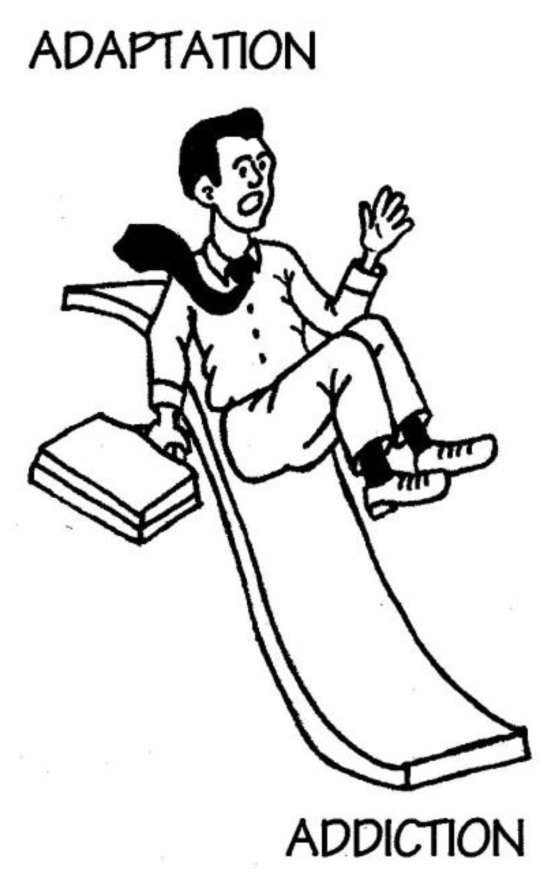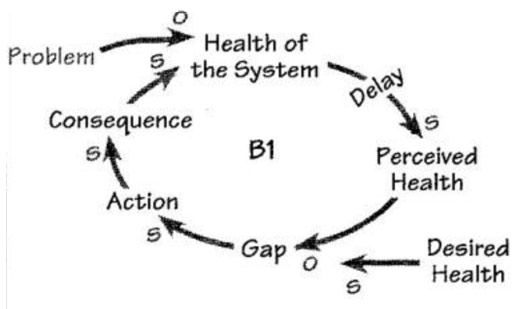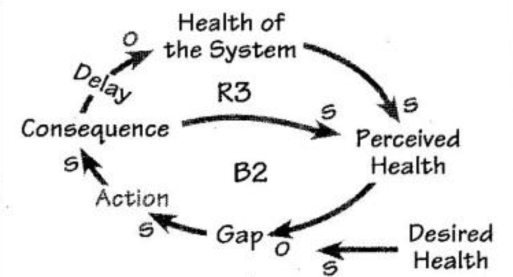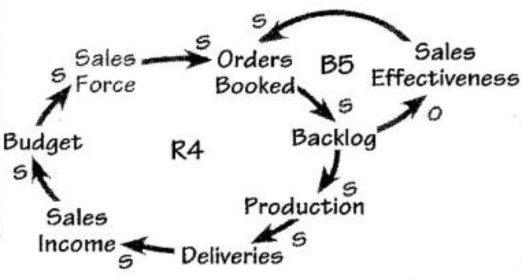Every so often in the world of business, we see an enterprise that, after years of steady progress and growth, suddenly experiences a drastic decline in its fortunes. Or we observe a senior manager, who has always been highly compensated and widely admired for her wisdom and skill, suddenly managing a string of failures. Why do these things happen?
As we will see, most organizations and people have mastered the ability to adapt to new situations and challenges. They can learn and improve, as long as the basic causes of their success do not change. But sometimes managers and enterprises become addicted to old ways of operating and making decisions, and thus fail to function well in a new environment. The result is decline. To understand the powerful dynamics that cause this turn of events, we must investigate the systems within which these organizations and managers operate.
Adaptation Versus Addiction
Adaptation and addiction differ in subtle ways. Adaptation takes place when we observe the symptoms of a problem and then take an action that counteracts the problem. Addiction occurs when we observe the symptoms of a problem and then take an action that suppresses the symptoms of the problem but makes the actual problem worse.
For example, lei’s say that you have just moved to a new area and find yourself spending a great deal of time alone. The number and quality of your social relationships are important indicators of the health of your personal system. Moving causes a decline in your system’s health when it leads to loneliness. An adaptive response to your loneliness could be to get involved with activities in your new community, to make connections with people at your new workplace, or to join a few clubs with members you find compatible.

The cause-effect mechanisms at work in this process are illustrated in the diagram “Adaptation” (p. 2). If the quality of your social life is important to you, then any change that causes loneliness in effect decreases the health of the system. After a delay, perceived health also goes down. When perceived health declines, the gap between perceived and desired health—between where you think your health is and where you want it to be—increases. So you take action to close the gap. In an adaptive system, the consequence of an action counteracts the problem and restores the health of the system. The whole process is a balancing loop that holds perceived health close to the level of health you actually desire.
But let’s look at another scenario, one of addiction. Say that when you find yourself feeling lonely, rather than trying to meet people, you have a few drinks. Drinking alcohol depresses the emotional center in your brain that causes you to experience loneliness. Thus, over the short term, the alcohol suppresses the symptoms of loneliness (sadness, self-pity, and so forth). But when you drink to an extreme, the quality of your social life deteriorates even further, making you even more lonely. So the action you took to ease the problem eventually only worsens it.
The cause-effect relations involved in addiction have two subtle differences from those associated with adaptation (see “Addiction” on p. 3). First, we take an action whose consequence raises our perceptions of the health of the system, but not the actual health. Second, our action actually damages the system’s real health.
Addiction, therefore, is a process by which an external problem can send us into a damaging cycle that quickly feeds on itself. Eventually, we don’t even need an external problem to spur us to take action; we simply generate our own internal problems through our addictive behavior—like someone who drinks salt water to quench his or her thirst.
Unfortunately, it is fairly easy to slide from adaptation into addiction, because it is usually difficult to measure the true health of any system. We often rely on symptoms—indirect measures—to determine the perceived health of the system. But information about symptoms typically comes to us only after a delay. The information also may contain deliberate biases or random errors. As a result, we take an action – that will eventually damage our true health, because the short-term symptoms cause us to feel better than we did before. A classic example of this pattern is smoking cigarettes, which can bring us immediate pleasure, but will also damage our health in the long run.
Adaptation

An Addictive Response in Organizations
Enterprises often become addicted to patterns of behavior that have brought them success in the past. They persist in pursuing policies that are no longer productive, until there is some sort of collapse within the organization, such as excessive outsourcing of technology until there is virtually no internal capacity left. This failure can happen when the feedback loops governing the firm’s success manifest a phenomenon called shifting dominance.
The “dominant” loop in a system is the one that principally controls the system’s behavior over a certain, often extended, period of time. When one loop dominates for a decade or more, a whole generation of managers, a set of control systems, and even a mythology grow up around the lever points that activate the loop governing the enterprise’s success; for example, “Marketing promotions are always the answer to a sales slump.” The company leaders see these lever points as the keys to their prosperity and act in ways that reinforce them.
But eventually, any loop will lose its dominance; another set of causal mechanisms will become more important. Then the usual lever points no longer lead to success, and the managers are left with a heritage of ineffective policies and irrelevant myths. At this point, the firm should drastically revise its policies. But often it simply redefines its measures of success so that the old policies still appear attractive. Why does this occur, and what can we do to prevent it from happening?
The Market Growth Model: Shifting Dominance at Ace Electronics
The concept of shifting dominance first became real to me in the 1960s when I encountered a model created by David Packer, an early member of the Industrial Dynamics Group at the Massachusetts Institute of Technology’s Sloan School of Management. Out of the group’s investigations evolved an elegant theory, later called the Market Growth Model, that illustrates the mechanics and importance of shifting dominance.
Packer and his colleagues applied system dynamics to a firm I will call Ace Electronics. In its earliest days, Ace had an enormously superior product. Its sales were limited only by the company’s capacity to market and sell the product. The dominant loop governing the firm’s profits was composed of its expanding sales force, growing orders and backlogs, swelling production capacity, and increasing deliveries (R4 in “Market Growth”). Because the budget for the marketing and sales department was a percentage of sales income, its budgets expanded, and the sales force grew even more. This loop produced rapid growth.
For a long time at Ace, the market growth loop was dominant, and a group of people who knew how to make this loop operate moved up through the firm’s ranks. However, eventually the dominance shifted within the system (B5 in “Market Growth”). The sales force booked far more orders than the factory could produce, so the order backlog started to increase. When the sales force could not promise timely delivery in a technologically sophisticated and rapidly changing market, its effectiveness in booking new orders declined. Sales began to drop. Before, expanding the sales force increased profits; now it cut into them.
Addiction

You might think that this shift in dominance from loop R4 to loop B5 would be immediately apparent to managers. But in a big firm, particularly one where the data systems have been developed to focus mainly on the reinforcing loop, the shift may not be obvious to the people caught up in the system. And when many of those people have egotistic or professional reasons for emphasizing the importance of the marketing function, they may even deny evidence that influence over profits has shifted to manufacturing.
When we find ourselves unknowingly caught up in a situation of shifting dominance, we often blame each other for our faltering fortunes. Ace is a perfect example of this phenomenon. We can imagine that the company leaders agonized over why the sales staff wasn’t as good as it used to be, what kind of new incentives were needed to whip the sales staff back into shape, and so forth. But in shifting dominance, the problem actually originates within the system in the form of an addiction to the old ways of doing things. Managers can push a sales force as hard as they like and still fail to revive sales—the system simply doesn’t respond to this kind of force when the control has shifted to a different loop.
Market Growth

As one particularly destructive result of Ace’s failure to adapt to change, the company eventually developed an addiction to a new, short-term “solution”: downsizing. Many companies fall into the trap of firing people in order to make the bottom line look good on the next quarterly report. Downsizing lowers costs and temporarily kicks up profits. But if it’s not done well—and often it isn’t—downsizing also drastically reduces the quality and size of the staff and dulls a company’s competitive edge. As its niche shrinks, the company has to fire even more people in order to boost its profits. The addictive cycle of downsizing takes over.
The Difficulties of Breaking Addiction
If the pitfalls of addiction seem so obvious, why is it so difficult to break out of addictive processes? There are three main forces that work against an individual or organization seeking to break the cycle of addiction.
The Pain of Withdrawal. One reason is that withdrawal is extremely painful. Remember that perceived health, which drives our actions in the addictive system, is affected by two factors: actual health and the consequences of the actions we take (see “Addiction” on p. 3). These addictive consequences progressively damage actual health, which means that we have to take more and more of the addictive action to offset the consequences. The process becomes a spiral of increasing use.
Codependency. When we get ourselves into the trap of addiction, it’s astonishing how the various components of the system work in collusion to sustain the addictive behavior. This subtle reorganization of the system to support the addictive action is called codependency and is another reason that breaking an addiction is so difficult.
Drifting Goals. Addiction has many forms. One interesting variant of the addictive structure occurs with the addition of a causal link that produces what is commonly known as “Drifting Goals.” If we don’t get what we want, we start to want what we get. When we lower our aspirations, the addiction causes progressive deterioration of our goal.
If we don’t get what we want, we start to want what we get.
For example, imagine a firm that borrows more and more in order to finance its operations. One symptom of a company’s health is its debt-equity ratio; there are industry standards that indicate the appropriate ratio of debt to equity in a healthy firm. When debt rises above this level, a company will undertake efforts to increase profitability or sell off assets to reduce debt. But if these efforts fail and the debt-equity ratio remains high, management may get used to the higher levels of debt and stop trying to reduce them. Spokespeople for the firm may even develop elaborate rationalizations indicating why the higher levels are acceptable. Of course, over the long term, high levels of debt can be fatal to an organization.
Understanding and Changing Systemic Structure
Addictive behaviors, with their self-perpetuating, destructive cycles, can seem particularly stubborn. But cycles of addiction can be broken, allowing us to respond more adaptively to situations of shifting dominance.
What is the key to breaking addictive responses in organizations? One place to begin is to familiarize ourselves with the laws of systemic behavior and learn to work with these laws (see The Fifth Discipline by Peter Senge). Most of the principles of systemic behavior apply directly to the process of addiction and contain the seeds of a solution (see “Moving Beyond Organizational Addictions” on p. 4).
The most effective way to combat organizational addiction is to learn to understand the system. When we do that, we can anticipate an imminent shift in dominance and prepare ourselves for it; in other words, we can design an adaptive instead of an addictive response. We can also identify opportunities to create new feedback loops that let us catalyze a desirable shift in dominance. But beware of spending too much time creating loops that aren’t going to dominate. The key is to make a change that will grip the system and take it down a different path.
To beat personal addictions, we often must place our trust in the potential of the system to change. Likewise, in organizations, if we build up confidence in a group’s ability to work together, to stay committed to each other, and to cope with problems in a way that will produce satisfactory results in the long run, we can get through withdrawal together. With the high turnover rates the business world is experiencing under downsizing, it has become harder for workers to place their faith in anyone or to adopt long-term perspectives. However, only trust can help an organization establish a sense of stability. Despite all the pressures to do otherwise, we must work to cultivate a culture of trust.
Herman Daly, a leader among economists in analyzing sustainable development, once made a statement that is profoundly applicable to the challenges discussed in this article: “The paths to sustainability are unknown, not because they’re hard to find, but because we never looked.” Let’s start looking for long-term solutions to organizational addictions.
Dennis Meadows is director of the Institute for Policy and Social Science at the University of New Hampshire. He directed the system dynamics graduate program at Dartmouth College for 16 years. He has written eight books that apply systems thinking to social and corporate issues.
Editorial support for this article was provided by the editorial staff and Joy Sobeck.
